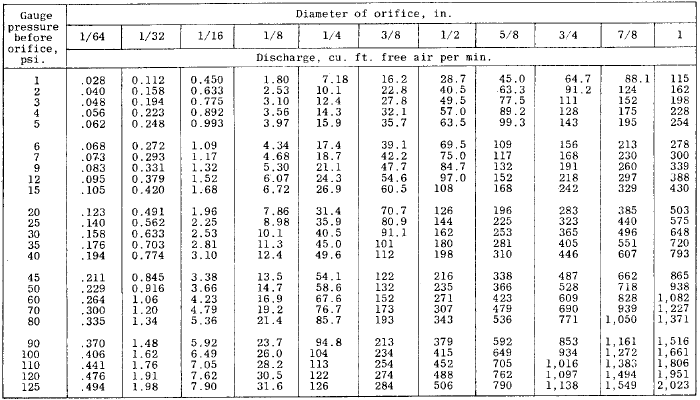Discharge of Air Through An Orifice Equation
Fluid Flow Table of Contents
Hydraulic and Pneumatic Knowledge
Discharge of Air Through An Orifice Equation and Calculator - Moss Formula
The table given below gives the discharge of air through an orifice in cu. ft. of free Air per minute at atmospheric Pressure of 14.7 psia, and 70 °F
Based on 100% coefficient of flow. For well-rounded entrance multiply values by 0.97. For sharp-edged orifices a multiplier of 0.65 may be used.
This table will give approximate results only. For accurate measurements see ASME Power Test Code, Velocity Volume flow Measurement.
Values for pressures from 1 to 15 psig, calculated by standard adiabatic formula.
Values for pressures above 15 psig, calculated by approximate formula proposed by S. A. Moss:
Formula 1.0
W = 0.5303 · A · C · P / T 1/2
Where:
W = discharge in lb./ sec.P = upstream total pressure in psia
A = area of orifice in in2.
C = coefficient of flow
T = upstream temperature in deg. R. .
psia = psig + atmospheric pressure (14.7 at sea level)
Area of circle = π r2
Values used in calculating above table were C = 1.0,
P = gauge pressure + 14.7 psi.,
T = 530 F. abs.
T(°R) = T (°F) + 459.67
Weights (W) were converted to volumes using density factor of 0.07494 lb. per cu. ft. This is correct for dry air at 14.7 psia, and 70 F.
Formula cannot be used where P is less than two times the barometric pressure.
Click of Chart Image to enlarge
Related:
- Air Density Equations and Calculator
- Air Density and Specific Weight Table, Equations and Calculator
- Viscosity of Air, Dynamic and Kinematic
- Orifice Plate Flow Calculations and Design
- Orifice Plate Type Flow Detector Review
- Velocity Escaping Compressed Air Equation and Calculator
Reference:
American Machinst,
September 20, 1906
Sanford A. Moss
Flow of Air and Other Gases, With Special Reference to Small Pressure Differences <- Free membership required to download
Flow of Air and Other Gases, With Special Reference to Small Pressure Differences -Part 2
